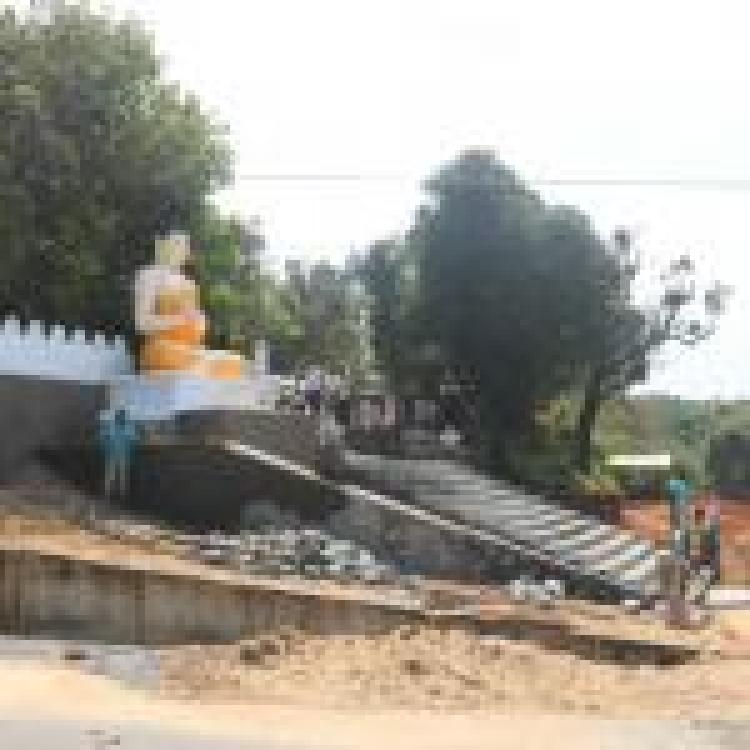
Local Tamils have expressed concern and outrage after an area previously known as Kachchal Samalankulam in Vavuniya has become ‘Sinhalised’ and has had its name changed to Sapumalgaskada and a signboard labelled ‘Sapumalgaskada Archaeological Site’ was put up in the area, last week.
The Sinhalisation adds to the expansion of colonisation across the North-East of Tamil areas, where Tamil names have been erased and converted to Sinhala names, and Tamil areas are becoming occupied by Sinhala settlers with the support of Sri Lankan military and government officials.
Kachchal Samalankulam colonisation
The Kachchal Samalankulam area, known for its archaeological significance, has been dismantled with the aid of Sri Lankan Forestry Department, under protection from the state military since 2013. The long-term expansion project carried out in the area, involved the demolition of old stone pillars and more recently further extensive construction work under the guise of repairing an old Buddhist shrine.
Previously, Tamil organisations and politicians have questioned the reasoning for erecting a Buddha statue and allowing Sinhala settlements at a known archaeological site, but the encroachment was allowed to proceed.

There are complaints and a growing fear from Tamil locals, politicians and elected council members that Tamil areas previously known to be open dense forests are now gradually being used to build houses to accommodate housing for Sinhala Buddhist settlers, with lower forest regions being cleared out quickly for small huts to be set up.

Buddhist statues and religious flags were also noted as increasingly being featured across the area.

Many wooden homes have been built to accommodate the Buddhist people being resettled in the area, by Sri Lanka Archaeology Department officials, Forest Department officials and hundreds of other workers and have been described as ‘luxurious accommodation’.
This area has been marked as the border between the North-Central Province and the Northern Province. The ancient villages in the Vavuniya District of the Northern Province such as Kachchal Samalankulam, Muthalikkulam, Ootrukulam and Kokachankulam are located near this border.
History of Vavuniya’s Sinhalisation Colonial Project
In the past, due to the armed conflict and violence in the border villages, the Tamils in the area were completely displaced and relocated to other areas and recently the villages are now becoming more populated with Sinhala settlers.
Sinhala settlements in the surrounding areas of Vavuniya has been documented since the 1990’s. The Padaviya settlement, North-Central Province – is said to have adopted its name from two components; Viya (Sinhala word for the large reservoir of water) and the Pada based on the original Tamil name of the area – “Pathi”. Tamil inscriptions have been found to validate Pathi being used during the Chola dynasty in 1150 CE and the Sinhalisation of the name was said to have occurred after the 1958 pogroms.
Madukanda was the first area to see large-scale settlement near Vavuniya and this has since expanded to surrounding areas such as Attambagaskada and Mamadu. Rapid Sinhala settlements and aggressive deforestation have taken place in the area since 2009. This expansion project has been accelerated and entered the borders of the North-Central Province and spread across the province. The settlements filled a part of the province completely and in 2014, entered the final border of the Northern Province, Vavuniya North. Until mid-2019 it spread to Vedivaittakallu in North Vavuniya. A well-planned new Sinhala settlement spanning from North Anuradhapura to the Southern part of Vavuniya North has been established.
These areas fall within the Mahaweli ‘L’ zone – which was the name given by the Sri Lanka Mahaweli Authority to approve Sinhala settlements on Tamil lands across the North-East districts; including Mullaitivu, Trincomalee and Vavuniya with security provided the Sri Lankan Task Force. The scheme angered many Tamils who feared over the future of their land rights and employment.
During the time of displacement, the area was occupied by the Sri Lankan military and over the past two years, the Sri Lankan Forest Department has prevented Tamil landowners from access to their own land while allowing hundreds of Sinhala settlers to use Tamil land for agriculture and building wooden huts as accommodation. The expansion of Sinhala settlers into these Tamil areas has been supported by numerous benefactors, including international philanthropists and the Sri Lankan government. The financial aid has been sent to ‘protect existing Buddhist ruins’ with Buddhist monks supported and entrusted in setting up new temples and buildings and offered accommodation on the Tamil-owned land.
Resistance against the Sinhalisation
Last year, there were reports that about 400 Sinhalese families have now been resettled in the Tamil village of Kokachankulam – which has now been renamed into the Sinhala name Kolbaswewa. Local Tamils sent out a Right to Information Act application form to the Vavuniya North Divisional Secretariat three months ago requesting the details on how many Sinhalese families reside in the area but these have been ignored. Tamil farmers and fisherman have also complained about the interference by both Sinhala settlers and government officials whilst attempting to work.
Many locals and civic members have complained that this also may be used as a ploy to reduce the Tamil representation during election periods that may further increase the marginalisation of political involvement of Tamils.
Similarly, there the Sinhalisation in the North-East extends to other districts such as Jaffna, in places such as Kankesanthurai – where there has been extensive militarisation and surveillance and in Mandaitivu last week, where local protests hindered Sri Lankan navy attempts to occupy Tamil-owned land. Both of these add to the rampantly escalating list of occupation efforts enabled by the Sri Lankan military that have heavily impacted the livelihoods of Tamils across the North-East.



